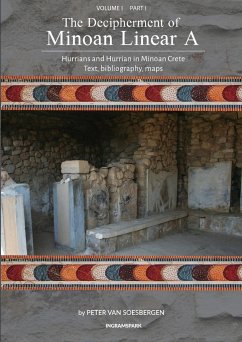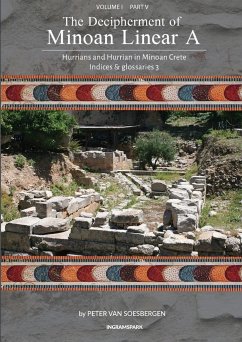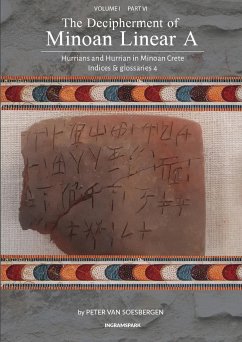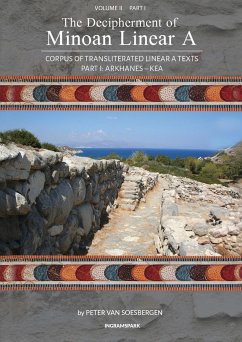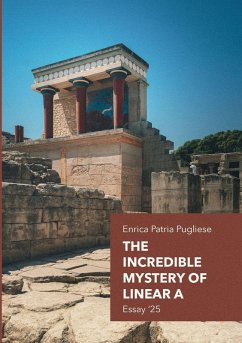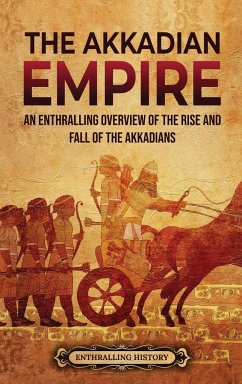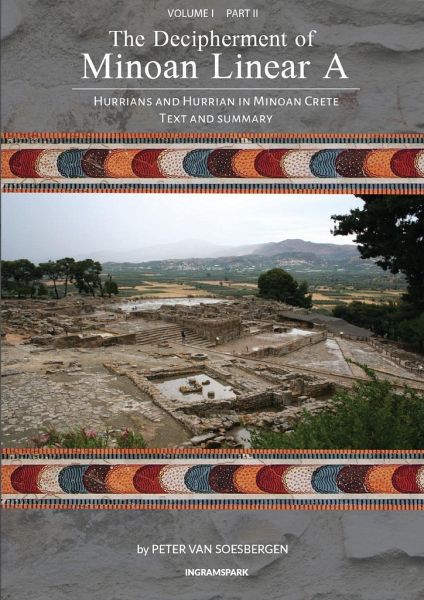
The Decipherment of Minoan Linear A, Volume I, Part II
Hurrians and Hurrian in Minoan Crete: Text and Summary
Versandkostenfrei!
Versandfertig in 1-2 Wochen
64,99 €
inkl. MwSt.

PAYBACK Punkte
32 °P sammeln!
Volume I, Part II, comprises (together with Part I) the main text in the series The Decipherment of Minoan Linear A. Volume I, Parts III-VI, are the indices to the main text and glossaries at the same time. The author shows that the Holy Trinity of the main Hurrian Gods, Teub, ¿ebat and their son arruma is addressed in a sophisticated, poetic way, usually at the beginning of the so-called libation formulas, by means of descriptive epithets. They appear in a fixed order of importance. First Teub's Linear A epithet a-ta-i-jo-wa-ja 'Our Father', absolutive/vocative attai=(j)=o/uwwa=(j)=a, consis...
Volume I, Part II, comprises (together with Part I) the main text in the series The Decipherment of Minoan Linear A. Volume I, Parts III-VI, are the indices to the main text and glossaries at the same time. The author shows that the Holy Trinity of the main Hurrian Gods, Teub, ¿ebat and their son arruma is addressed in a sophisticated, poetic way, usually at the beginning of the so-called libation formulas, by means of descriptive epithets. They appear in a fixed order of importance. First Teub's Linear A epithet a-ta-i-jo-wa-ja 'Our Father', absolutive/vocative attai=(j)=o/uwwa=(j)=a, consisting of attai 'father' + transitional semi-vowel -j- between 2 vowels + enclitic possessive pronoun 1st person sing. -o/uwwa- (my) + transitional semi-vowel -j- between 2 vowels + the pluralizer -a (our). Compare cuneiform Hurrian dTe-e-e-u-pa-a ........ eb-ri-iw-wa-u-u at-ta-iw-wa-u-u (3 ergatives), 'Teub .... Our Lord, Our Father' in the Turatta letter (Mit. IV 118). Then the epithet of Teub's wife ¿ebat, a-di-ki-ti/e(-te), analysis adi-dagitti, 'The woman is a beauty / beautiful' > 'The (most) beautiful woman', appears (in haplography) in the libation formulas. The form is attested as a-di-da-ki-ti (KN Zc 6.2) in scriptio plena on the interior of a Middle-Minoan III cup at Knossos (adi = 'woman'). In Linear A and B -s- preceding an occlusive is not expressed in consonant clusters. Then the epithet of the young god arrum(m)a appears as a-sa-sa-ra-me, analysis ara-arr=a=me, 'The young man/boy, he is like the King of Gods'. The Linear A variant ja-sa-sa-ra-ma -na (KN Za 10a-b) can be analysed as y(a)/y(e)-ara-arr=a=mann=a, 'as well as "The young boy (ara 'young man') is (mann=(i)a) like the King of Gods" ', (arr=a is the essive of Hurrian arr=i 'King of Gods'). The contents of the prayers in the 'libation formulas' appear to be about the same subject as the meaning of many personal names, in which the birth of healthy children, sometimes after the death of an older child, is always in the minds of the parents. Linear A u-na-ka-na-si, Hurrian un=a-¿(¿)an=a=i 'come childhood, childbirth' is an essential term occurring in almost every formula. It may not be accidental that the name Arkhanes is attested as a]-ka-ne (AK 3a.1+fr. AK.1b.1, join P.G. van Soesbergen) on a Linear A tablet found in the Minoan Villa of Epano Arkhanes. Even more significant is the fact that the toponym can be analysed as Hurrian ar=¿ane/i 'Give a child' and that the Villa of Arkhanes may well have been the starting point for supplicants and priests to go upto the Peak Sanctuary of Mount Ioukhtas to pray to Teub, ¿ebat and arru(m)ma. See for an extensive analysis Chapter 11: 'Religious' Linear A insc



